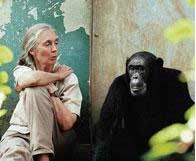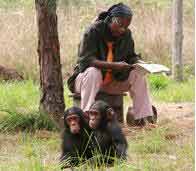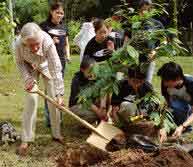VOICE ONE:
I'm Doug Johnson.
VOICE TWO:
And I'm Faith Lapidus with EXPLORATIONS in VOA Special English. Jane Goodall is one of the most well known scientists in the world. She has spent most of her career studying wild chimpanzees in a protected area of Tanzania called Gombe National Park. Over the past 50 years, she has made very important discoveries about the social behavior of chimpanzees.
Today, Miz Goodall spends most of her time traveling around the world speaking about wildlife protection and working to build support for her foundation. She recently wrote a book about endangered animals.
(MUSIC)
VOICE ONE:

Ever since she was a child growing up in England, Jane Goodall dreamed of working with wild animals.
JANE GOODALL: "As long as I can remember, it was animals, animals. Even before I could talk, I was watching earthworms and things, reading Doctor Doolittle books, wanting to learn the language of animals. Then finding the books about Tarzan, falling in love with Tarzan."
When she was about 11 years old, she decided that she wanted to go to Africa to live with and write about animals. But this was not the kind of thing young women growing up in the 1940s usually did.
JANE GOODALL: "Apart from my mother, everybody laughing, she would say if you really want something, you work hard, you take advantage of opportunity, you never give up, you find a way. So, eventually a school friend invited me to Africa."
VOICE TWO:
In 1957, Jane Goodall traveled to Africa. She soon met the well-known scientist Louis Leakey and began working for him as an assistant. He later asked her to study a group of chimpanzees living by a lake in Tanzania. Very little was known about wild chimpanzees at the time. Mr. Leakey believed that learning more about these animals could help explain the evolutionary past of humans.
JANE GOODALL: "That led to this extraordinary opportunity to study, not just any animal, but chimpanzees. I wouldn't have aspired to that. I mean, I had no degree. I wasn't qualified, I thought. He thought differently."
VOICE ONE:
Louis Leakey thought Jane Goodall would be a perfect candidate for the job. She had spent much of her time reading and writing about animals. And, she was not a trained biologist. He believed this would keep her mind open to new discoveries.
Observing chimps was not easy work. They were very shy and would run away whenever Miz Goodall came near. She learned to watch them from far away using binoculars. Over time, she slowly gained their trust. She gave the chimps human names such as David Graybeard, Flo and Fifi.
VOICE TWO:
Giving the chimps human names was a very unusual method. Most researchers would have identified the animals using numbers instead of names. But Miz Goodall believed that to understand animal behavior, the observer had to see the animals as individuals, not as interchangeable objects. Watching the chimps, she learned that they have very different personalities, with complex family and social relationships.

Early on in her work at Gombe, Miz Goodall made some very important and surprising discoveries. For example, many people then believe that chimpanzees only ate vegetables and fruits. But she observed that they were also meat eaters and skilled hunters. A few weeks later, she made an even more surprising discovery. She saw chimps making and using tools to help them trap insects.
JANE GOODALL: "I suppose the first really significant thing that the world heard about was chimpanzees using and making tools. It was thought that only humans did this and that this set us apart from the rest of the animal kingdom."
VOICE ONE:
Jane Goodall wrote Louis Leakey to tell him about her discovery. He responded by saying: "Now we must redefine 'tool', redefine 'man', or accept chimpanzees as human."
Up to this point, Jane Goodall still did not have a degree. She returned to England to begin working towards a doctorate in animal behavioral science. She received her degree from Cambridge University in 1965.
(MUSIC)
VOICE TWO:
Jane Goodall spent many years studying chimps in this area of Tanzania. Today, the research program at Gombe represents one of the longest continuous wildlife studies in the world.
Miz Goodall has written many books for adults and children about wild chimpanzees. Her scientific research was published in the book "The Chimpanzees of Gombe: Patterns of Behavior."
It explains her discoveries about chimp behavior, including the extremely close relationship between mother and child. She describes the chimps' intelligence, their hunting activities and their sometimes extremely aggressive behavior.
VOICE ONE:

Although she has spent her life trying to protect chimps in their natural environment, these animals are still very much in danger. Miz Goodall says when she began working in Tanzania, there were between one and two million chimps in the wild. Today, she says there are about 300,000 at the most.
JANE GOODALL: "It's different in different countries. Chimps are in 21 nations. In countries like Tanzania, it's simply habitat destruction. But when we come to where the large significant populations are, which is the Congo basin, then we find that it's the bush meat trade that's the commercial hunting of wild animals for food. And, it's made possible by the logging companies, foreign logging companies, opening up the forest with roads."
VOICE TWO:
The destruction of the chimp's natural environment led Miz Goodall to give her full attention to protection efforts. She spends about 300 days out of the year traveling around the world to discuss her many projects and goals. She talks about the efforts of the Jane Goodall Institute which she started in 1977. Its aim is to increase public understanding of great apes through research, education, and activism.
The group teaches local communities how to manage their resources in ways that help them economically and protect the environment. It also has a sanctuary where baby chimps whose parents have been killed by hunters can receive treatment and protection.
VOICE ONE:

The Institute's "Roots and Shoots" program is aimed at getting young people interested in environmental activism and leadership. The group has helped connect young people who are interested in working to save animals and the environment.
JANE GOODALL: "Hundreds of thousands of young people around the world can break through and make this a better world for all living things. Main message? Each one of us makes a difference every single day we impact the world around us and if we would just think about the consequences of the little choices we make -- what we eat, wear, buy, how we interact with people, animals, the environment --then we start making small changes and that can lead to the huge change that we must have."
(MUSIC)
VOICE TWO:
Jane Goodall's most recent book is called "Hope for Animals and Their World." It tells about efforts to save several species of endangered animals.
JANE GOODALL: "I think the one story that inspired this book was meeting a wonderful man called Don Mertin in New Zealand and he explaining to me how he had saved a species of bird called a Black Robin when there were just seven individuals left in the world of which only two were female and only one of whom was fertile."
VOICE ONE:
Some of the species Miz Goodall discusses in the book have completely disappeared in the wild, and are only alive because they have been bred in captivity.
The California condor is another such example. This huge bird used to live along the West Coast of North America. By the 1980s, there were only a few condors left in the wild. In a disputed decision, officials took the wild condors into captivity so that their breeding could be supervised and protected. The goal of such programs is to later place the species back into the wild. But preparing the captive bred condors to live in the wild again has not been easy. Threats the condors face in the wild include lead poisoning and mistaking trash for food.
VOICE TWO:
Other species in the book still exist in the wild, but are endangered. One example Jane Goodall discusses is the Golden Lion Tamarin. She tells about the hard work of a group of researchers who have successfully released these monkeys back into protected areas of Brazil. Her book shows what is possible when people come together to work cooperatively to save animals.
VOICE ONE:
Jane Goodall has said that it is often easy to feel upset about the destruction of the natural world. But her overall message has always been one of hope.
She says her hope comes from her belief in four things: the human brain, the human spirit, nature's strength and the energy of young people. She says people are starting to use their minds to solve the world's many problems and make wiser and more responsible choices. And, she believes in the strength of the human spirit which allows people to reach goals which might otherwise seem impossible.
(MUSIC)
VOICE TWO:
This program was written and produced by Dana Demange. I'm Faith Lapidus.
VOICE ONE:
And I'm Doug Johnson. Transcripts, MP3s and podcasts of our programs are at voaspecialenglish.com. Join us again next week for EXPLORATIONS in VOA Special English.
condor: either of two very large rare New World vultures, Vultur gryphus (Andean condor), which has black plumage with white around the neck, and Gymnogyps californianus (California condor), which is similar but nearly extinct 兀鷹
Golden Lion Tamarin: a small arboreal Brazilian monkey (Leontopithecus rosalia), having a silky golden coat, lionlike mane, and long, partially webbed digits
Related stories:
噓!母猩猩交配時(shí)要保持安靜
研究:黑猩猩也用擁抱親吻表達(dá)安慰
研究:5歲黑猩猩記數(shù)字賽過(guò)大學(xué)生
'New' giant ape found in DR Congo
(Source: VOA 英語(yǔ)點(diǎn)津編輯)